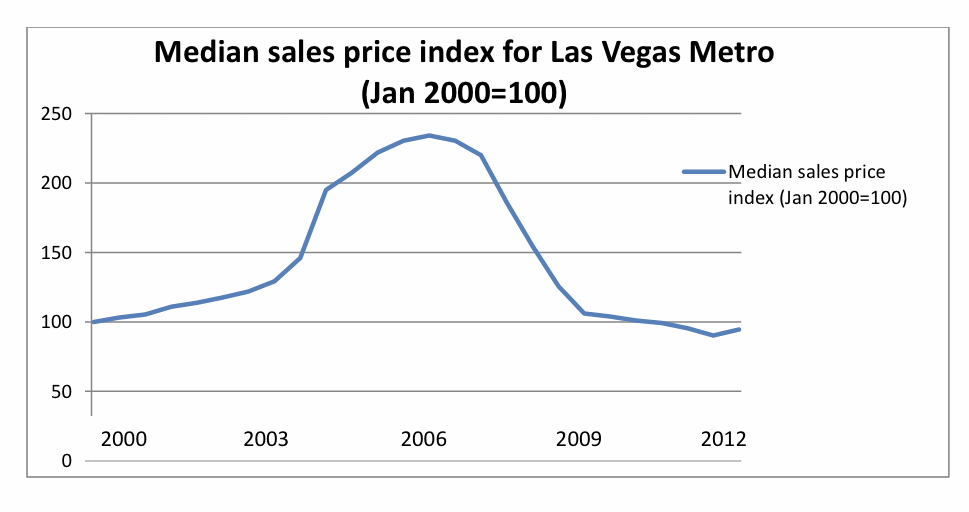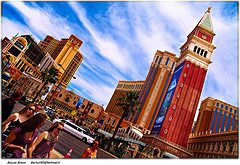I recently spent a few days in Las Vegas meeting with housing and real estate people of various stripes. Compared to a similar visit about two years ago, the difference was amazing. Two years ago, doom and gloom were pervasive. Today, a sense of optimism, albeit cautious rather than exuberant, was in the air.
House prices were up, people told me, builders were starting to put up houses again. While nobody expected a repeat of the boom years—and most people were quick to say they didn’t want one—there was a feeling that the worst was over, and things were on a positive course.
The numbers seem to support them. According to Case-Shiller, house prices are up by 7 percent through August, since bottoming out in March. Building permits are up by 39 percent for the first nine months of 2012 compared to 2011. Nothing dramatic, but positive. So, what is going on?
Since the bubble burst, back at the end of 2006, two things have driven the housing market in Las Vegas: foreclosures and investors. It’s not too much of an oversimplification to say that, for most of the last six years, the market could be defined as “banks foreclosed on houses and investors bought them.” At the peak in 2009, three out of four sales were REOs, and consistently half or more of all buyers were—and still are—investors.
The underlying dynamics haven’t changed, but the way the players deal with them has. Lenders have become more intelligent about dealing with properties in default. In 2008 and 2009, properties by the thousands were being foreclosed and dumped on the market. As investors and speculators, mostly homegrown, realized this, the market started to look like a feeding frenzy. A lot of the people getting into the market were flippers, who bought houses at rock bottom prices, put a little money into them, and resold them, often to other—often out of town—investors. Meanwhile, so many homes and condos were flowing into the market that prices kept going down.

By 2010, people were starting to think twice. In 2009, the state of Nevada created one of the nation’s better foreclosure mediation programs, while the lenders were starting to rethink the way they were operating. Gradually, their approach shifted away from foreclosure. By this fall, REOs made up less than 20 percent of all sales, while short sales, which were hardly a blip on the radar a few years ago, were approaching half of all sales. Some banks are now offering homeowners a three year lease to stay on as renters in return for the deed to their home.
This was not entirely voluntary. Nevada has made it a lot tougher to foreclose. AB 284, enacted in 2011 in response to the robo-signing scandal, drastically tightened the screws on foreclosing lenders; as one reporter described it, “the law makes it a felony for loan servicers to sign documents without ‘personal knowledge’ of who owns the note, and requires lenders to provide an affidavit showing they have authority to foreclose.” Once the bill went into effect, notices of default—the first step in foreclosure under Nevada law—went from 5,000 a month to under 1,000. A year later, they’ve only come back to 1,500. With far fewer foreclosures taking place, inventory has shrunk. There is talk of repeal when the legislature comes back next year, but attorney general Cortez Masto, who has built her political career around these issues, sees no reason to change it.
Meanwhile, the number of investors in the market has grown. According to people I talked to, a new breed of investor, mostly notably from China, but also from Korea, Taiwan, Singapore and elsewhere, is eager to buy property in Las Vegas. Few of the new buyers, though, are flippers. With prices higher, and too many people competing for a smaller inventory, the edge isn’t there any more. The new investors are buying to hold—not forever, but at least three to five years—while making about 8 precent return on the rental income, and hoping for a payoff in appreciation at the end of the road.
With investors hungry for inventory, builders have started to build again, property values have started to move upward in the condo market, which has lagged badly behind single family sales, as well as in some distressed areas that were being written off two years ago. The imminent arrival of Zappo’s in downtown Las Vegas with 1500 jobs, and the announcement that Tony Hsieh, its flamboyant CEO, will invest $200 million in real estate, have also given some close-in, lower-end neighborhoods a shot in the arm.
Is it real? Yes and no. According to CoreLogic, around 75,000 Las Vegas homeowners are 90 days or more behind on their mortgages. That’s quite a shadow inventory: one out of every five homeowners in the area who are basically not paying their mortgage, and waiting out the lender. There’s been little job growth in the area; while unemployment is down by 20,000 from a year ago, that has more to do with the continued shrinking in the workforce than with job growth. At least the supply of rental housing still seems strong, and while rents may be inching up, they are still relatively affordable for most Las Vegas households.
People who want to buy a house for themselves to live in, though, are having a hard time of it. Investors are cash buyers, so the seller has no appraisal contingency or mortgage contingency to worry about, and can count on a quick closing with the investor taking the house in “as-is” condition. Excessive investor activity helped fuel the bubble in Las Vegas a decade ago; while the bubble is unlikely to return, it is still no recipe for a long-term, sustainable housing market. It remains to be seen whether the recent uptick in the market is a sign of long-term improvement, or a momentary blip before a second downturn.
Photo by Moyan Brenn, Creative Commons BY-SA.






Comments